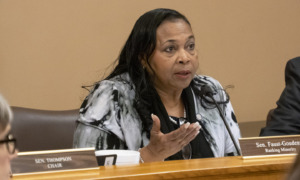
Versta/Shutterstock.com
.
WASHINGTON — Recently passed federal legislation is revolutionary in its approach to reorganizing the nation’s foster care system, reform advocates agree, but some are worried that the pace of change may overwhelm an already stricken child welfare system.
The Family First Prevention Services Act was quietly slipped into a larger budget package that passed both houses of Congress in February. Among other things, it allows states to use funding under Title IV-E of the Social Security Act for programs and services designed to keep youth out of foster care. Although the bill and several like it have been the subject of reform efforts for several years, the act’s passage caught many advocates off guard.
Few advocates reject the principles behind the effort — consensus has slowly emerged over the past few decades that youths are best off staying with their families and out of foster care — but some worry the act wasn’t carefully thought out before its surprise passage.
“The kinds of services that they allow you to pay for are way too constrained and the point of time that you can access the money is way too late, so states are going to have trouble accessing the money as the kids come into care,” said Scott McCown, director of the Children’s Rights Clinic at the University of Texas.
Among the concerns McCown says he has is an early analysis from the Congressional Budget Office that projected the act would reduce federal spending by some $66 million over the next 10 years.
“These are good goals, but it’s going to be very difficult to implement the legislation. And there are concerns about what happens if we fail,” McCown said. “What’s the saying, you don’t want to make perfect the enemy of the good? But I think there’s a real question about whether this is going to be a better system than we’ve had. You don’t want to trade down.”
Deadline Looming
Focus now shifts to the U.S. Department of Health and Human Services, which has until October, 2019 to come up with new regulations to implement the act. States are also required to submit their own plans for preventative services.
These changes are long overdue, said Jeremy C. Kohomban, president and CEO of The Children’s Village, a private, nonprofit social services agency based in Harlem.
“We have spent 100 years separating kids from families, needlessly. We now know — and we’ve known this for going on 30 years — that kids do best when they’re with their families unless they’re absolutely in danger,” he said.
Kohomban has championed the act for years; in 2016, he testified before Congress on its behalf. He said he “doesn’t believe for a second” that the intent of the act was to reduce spending — and, in fact, drafts of President Donald Trump’s current budget include spending increases for preventative services, Kohomban said.
“The historical model in the United States has been a residential model. It’s an old model that’s difficult to dissemble. With anything new, you can always come up with hypotheticals that can go wrong and there is always the risk of unintended consequences, but the intent here is to keep families together whenever possible,” he said.
As Kohomban sees it, the act is a long-closed door that’s suddenly sprung open. He said he’s optimistic that state welfare officials will walk through it.
“The first thing we need to look out for is what will the state implementation plans look? Are they capitalizing on the opportunity to create good, front-end prevention? Do the state plans focus on good prevention? Do the state plans embrace good evidence- based and evidence- driven programming? Do the state plans provide for good, targeted, well-supported clinical interventions at residential facilities?” he said.
McCown said he hopes that advocates such as Kohamban are right — but his trepidation remains.
“What the proponents of the bill will tell you is that there is an opportunity for the state to save money by using new dollars on diversion services so that you can divert kids from foster care,” McCown said. “And that’s a great thing and I’m glad we’ve had this kind of paradigm shift… but there’s a lot of complexity of that, that they’ve just blown by. The goals are good goals, but it’s going to be extremely difficult for the states to implement.”
According to Casey Family Programs, Family First is designed in part to:
- Allow states to use open-ended Social Security funds for prevention services and programs for up to 12 months for at-risk youth and families, without regard to income;
- Allow for federal foster care maintenance dollars to go to parents who take care of their children while in a licensed residential, family-based treatment center, without income eligibility;
- Require the Department of Human Services to publish new model licensing standards for relative foster family homes by October, 2018.
- Promote placement in foster family homes “by outlining conditions for what placements will be eligible for … foster care maintenance payments for children placed in settings other than family homes known as Qualified Residential Treatment Programs (QRTP).”































